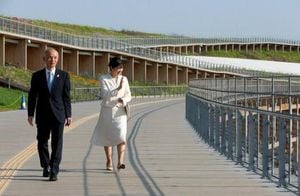In a significant move for Vietnam's automotive industry, Ninh Bình province has officially commenced the construction of a new automobile parts factory with an investment of nearly 1,400 billion VND (approximately 59 million USD). This development aims to bolster the local manufacturing sector and enhance Vietnam's position in the global automotive supply chain.
The factory, which is expected to create numerous jobs and stimulate local economic growth, is part of a broader strategy to attract foreign investment and improve industrial capabilities within the region. The Vietnamese government has been actively promoting such initiatives to ensure the country remains competitive in various sectors.
According to the Ministry of Construction, as of now, 13,201 billion VND of public investment capital has been disbursed, achieving about 15.88% of the planned target for 2025. This reflects the government's commitment to infrastructure development and economic growth.
In addition to the automotive sector, significant investments are also being proposed for transportation infrastructure, including a new expressway connecting Quang Ngai and Kon Tum, with an estimated cost of 44,355 billion VND. This expressway is expected to enhance connectivity and facilitate trade, further contributing to the economic development of the regions involved.
Meanwhile, the Thai business community is keenly observing the evolving investment landscape in Vietnam. Praween Wirotpan, President of the Thai Chamber of Commerce in Vietnam (ThaiCham), highlighted that Thailand ranks ninth among countries investing in Vietnam, with total investments reaching 14.3 billion USD since 1988. Thai companies are diversifying their investments across various sectors, including manufacturing, logistics, banking, and agriculture.
Wirotpan noted, "The investment appetite of Thai investors is quite diverse. We have established a strong presence in many fields, from production and processing to retail and energy. Many large corporations such as ThaiBev, C.P. Group, SCG, and Bangkok Bank are performing well in Vietnam." This diversification indicates a robust interest from Thailand in Vietnam's economic prospects.
As Thai businesses continue to shift production to Vietnam, notable projects include the establishment of industrial parks by Amata and snack production facilities in Bình Dương. This shift is largely driven by the desire to capitalize on Vietnam's position as a global manufacturing hub.
Moreover, the Thai companies are increasingly engaging in mergers and acquisitions (M&A) within Vietnam. In 2024, Thai businesses led M&A activities in the country, with significant deals involving well-known brands like Big C and Sabeco. Wirotpan emphasized, "The dynamic relationship between Thai and Vietnamese businesses is fostering a mutually beneficial partnership that yields positive results for both sides."
Despite the promising outlook, challenges remain. Wirotpan pointed out that Vietnam must navigate various regulatory hurdles, particularly concerning global minimum tax policies and producer responsibility initiatives. Additionally, uncertainties in U.S. trade policies under the Trump administration pose competitive challenges for Vietnamese exports.
On another front, the Bangkok Post reported that Thai tourism businesses are increasingly concerned about losing their status as the premier destination in Southeast Asia to Vietnam. The rapid growth of Vietnam's tourism sector has been impressive, with a nearly 50% increase compared to pre-pandemic levels. In contrast, Thailand's tourism growth has been slower, prompting fears that Vietnam could surpass Thailand in international tourist arrivals within the next few years.
Thanet Supornsahasrungsi, Chairman of the Chon Buri Tourism Association, stated that Vietnam aims to welcome 23 million international tourists this year, while Thailand has revised its forecast down from 38.5 million to 36.5 million. In March 2025, Thailand recorded 2.7 million tourist arrivals, a 20% decrease from 2019, while Vietnam welcomed over 2 million tourists, marking a 40% increase.
Vietnam's competitive advantages include lower living costs, modern resorts, and more affordable travel packages. Many travel companies are shifting their focus from traditional destinations like Phuket to emerging coastal cities in Vietnam, such as Nha Trang, due to these cost advantages.
Thanet also praised Vietnam's modern airport infrastructure, which allows for easier access to tourist attractions. "Many airports in major cities are built to international standards, making it easier to open new routes," he said. In contrast, travel times from Bangkok to popular destinations can exceed three hours, which may deter tourists.
In light of these developments, the Association of Thai Travel Agents (ATTA) has requested government support of 320 million baht (approximately 8.7 million USD) to attract more Chinese tourists. If approved, this initiative could generate significant revenue, estimated at 8.3 billion baht (around 245 million USD), by targeting the lucrative Chinese market.
As both countries navigate their respective economic landscapes, the competition between Vietnam and Thailand highlights the dynamic nature of Southeast Asia's growth. With Vietnam's rapid advancements in manufacturing and tourism, the future promises to be intriguing as both nations strive to enhance their positions in the region.




